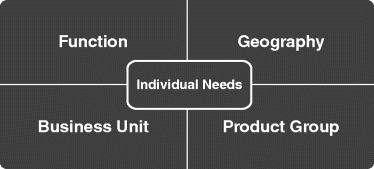Chapter 4Global Teams: Beyond FacilitationWhy Matrix Teams Fail and How to Get Better Results
Working in the Matrix
One of the biggest visible impacts of the world's shifting center has been the transformation of organizational structures from centralized, hierarchical models to fluid, matrixed organisms. The transformation has been an evolutionary necessity for organizations trying to scale their operations across multiple geographies.
The matrix structure is a technique for managing an organization through a series of overlapping reporting relationships to create balance between the needs of various functions, geographies, business units, and product groups. Figure 4.1 depicts these common elements of many matrix organizations—some may have two or three and others all four. This structure is designed to facilitate rapid response to change in two or more environments, while flatter structure and multiple reporting lines permit a freer exchange of information. All these elements are critical to organizational agility within a fast-paced global economic reality.

Figure 4.1 Common Matrix Elements
Matrix organizational structures are commonly deemed the best antidote to unhealthy silos that isolate groups of employees from one another in separate units. Such silos are conducive to finger-pointing—engineering blames sales for not selling great products, but meanwhile sales blames ...
Get Leading Across New Borders: How to Succeed as the Center Shifts now with the O’Reilly learning platform.
O’Reilly members experience books, live events, courses curated by job role, and more from O’Reilly and nearly 200 top publishers.

